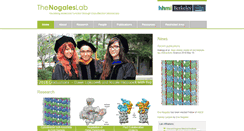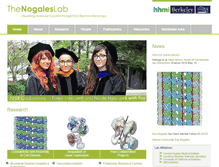Nogales Lab - CryoEM
OVERVIEW
CRYOEM.BERKELEY.EDU RANKINGS
Date Range
Date Range
Date Range
LINKS TO WEB SITE
Biochemistry, Biophysics and Structural Biology. Genetics, Genomics and Development. Division of Neurobiology - Phosphorylation of mTOR in neurons in the striatum. Division of Biochemistry, Biophysics and Structural Biology - Structure of the human Ndc80 kinetochore complex around microtubules. Division of Genetics, Genomics and Development - Heterochromatin dynamics in Saccharomyces cerevisiae.
Scientists have long used X-rays to peer beneath the surface of solid objects. Click the cover image to read the latest issue. Polymer nanoflowers designed for efficient electrodes. Novel sample preparation helps researchers expose eggshell secrets.
Exploring molecular mechanisms of RNA-mediated gene regulation. Collecting X-ray diffraction data at the Advanced Light Source. Ancestral cGAS homologs reveal evolution of innate immune signaling. Operating the ITC in our lab in Stanley Hall. Macromolecular crystallography facilitated by robotics at UC Berkeley. Analyzing RNA samples using gel electrophoresis in the lab.
We study the primary cilium, a surface-exposed organelle required for vision, olfaction and developmental signaling and whose dysfunction leads to. 8203; obesity, skeletal malformations and kidney cysts. To decode the fundamental principles of ciliary trafficking and to understand. How trafficking shapes signaling at the primary cilium, we leverage. A broad expertise in biochemistry, proteomics, cell biology and in vitro reconstitution.
WHAT DOES CRYOEM.BERKELEY.EDU LOOK LIKE?



CRYOEM.BERKELEY.EDU HOST
BROWSER ICON

SERVER OS AND ENCODING
I diagnosed that this domain is employing the Apache server.PAGE TITLE
Nogales Lab - CryoEMDESCRIPTION
Regulation of Gene Expression. Structural Basis Of Microtubule Dynamic Instability. Septin Structure and Assembly. Microtubule Dynamic Instability and its regulation. Septins Assembly and Interactions. RNA Processing by the Exasome. Eukaryotic DNA Replication Origin Recognition Complex ORC. Proteasome Structure and Function. RNA Processing by the Exosome. Has been elected Fellow of ASCB. Howard Hughes Medical Institute. Lawrence Berkeley National Laboratory. University of California at Berkeley.CONTENT
This website cryoem.berkeley.edu has the following on the web site, "Structural Basis Of Microtubule Dynamic Instability." We viewed that the webpage also said " Microtubule Dynamic Instability and its regulation." It also said " RNA Processing by the Exasome. Eukaryotic DNA Replication Origin Recognition Complex ORC. RNA Processing by the Exosome. Has been elected Fellow of ASCB. University of California at Berkeley."SEEK SUBSEQUENT DOMAINS
The laboratory of Molecular Electron Microscopy, headed by Tamir Gonen, is located at the Janelia Research Campus. Of the Howard Hughes Medical Institute. To get in touch, visit the Contact Us.
Electron cryomicroscopy of protein complexes, viruses and cells. Our group studies the architecture of large protein assemblies in order to understand basic molecular mechanisms that control protein and membrane traffic in the cell and virus infection. We apply electron cryomicroscopy and image analysis to study the structure of purified protein complexes in frozen solution. We use electron cryotomography to directly image cells in a frozen-hydrated state providin.
Three-dimensional reconstruction of the bacteriophage CUS-3 virion. Produced by the Timothy S.
The Most Accurate Frozen Sections Processor. What the Doctors are Saying. I am in favor of anything that improves the efficiency of my operation. I believe that eventually all labs will incorporate this unique procedure for tissue processing. The cryoEMBEDDER , once tried, will become an essential part of Mohs surgery and a useful tool for all frozen sectioning. I highly recommend this technique and give it my endorsement. Dermatologist, University of Utah.